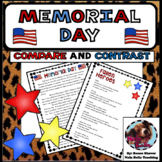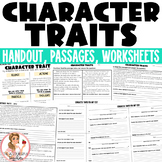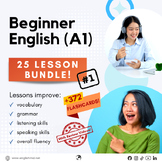50 results
High school literature homeschool curricula for Easel Activities
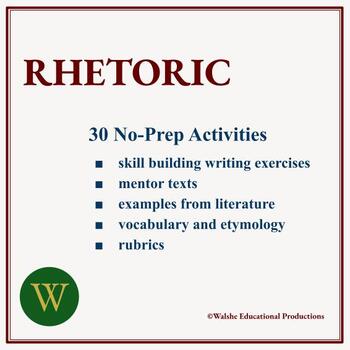
Thirty Rhetoric Lessons
These thirty no-prep lessons are written to give students the chance to learn rhetorical techniques while getting uncomplicated, focussed writing practice. Each lesson includes explanations, original examples and examples from literature and a rubric.These lessons, like all my lessons, are made to be accessible to students by giving them the opportunity to practice their skills in the context of their own abilities and needs. This set of 30 Rhetoric lessons is available separately or as part of
Subjects:
Grades:
9th - 12th, Higher Education, Adult Education
CCSS:
Also included in: Writing and Rhetoric 80 Lesson Bundle

Let's Go to the Theater: Summary and Critique
Let's Go to the Theater - Summary and Critique:This workbook is an opportunity for students to write a summary and critique of a musical, play, or movie based on a musical or play. It can be used for in class assignments, homework, or field trips. Teachers can choose the story based on the age of the students. NOTE: Students can use images and words for the writing process. Key Words: Musicals, Plays, Movies, Books, StoriesFor more fun resources, visit Creativity in Motion on TPT!
Subjects:
Grades:
1st - 12th, Higher Education, Adult Education
Also included in: HIGH SCHOOL ELA BUNDLE: SPRING AND SUMMER

Analyzing a Fictional Character Writing Activity | Print| Google| Easel
Your students will love learning to analyze characters in fiction. It will make everything they watch and read more meaningful. Becoming proficient at character analysis will enhance a student's reading experience. He or she can apply what they have learned to fictional characters in novels, movies, and TV shows.************************************************************************************************************SAVE $$ Click here to buy this resource along with several others in the Creat
Grades:
9th - 12th, Adult Education
Also included in: Creative Writing Exercises and Activities Bundle | Print | Digital

How to Use a Dictionary & Thesaurus (with Easel Activity)
How to Use a Dictionary & Thesaurus includes a short history of the dictionary and how it has changed, how to get started looking words up in a dictionary, how to use guide words in a printed dictionary, the types of information you can find in a dictionary, how online dictionaries can be different, what a thesaurus is, and how both physical and online thesauruses are used. It also included numerous worksheets including: • fifteen notebooking pages that guide students through looking
Subjects:
Grades:
3rd - 11th
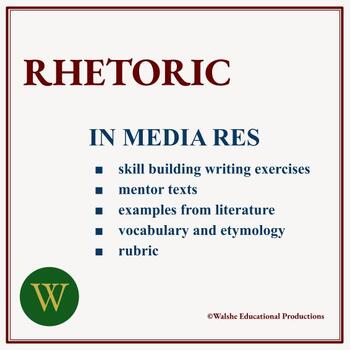
Rhetoric Lesson Twenty-five: In Media Res
Rhetoric lessons are a great way of introducing students to figures of speech and how to use them. This no-prep lesson in In Media Res is the twenty-fifth in my series of thirty rhetoric lessons. Simple, easy to follow instructions and examples are included, along with practice exercises and a rubric. I use these lessons with students from grades 7 to 12. They enjoy the simple challenge of writing according to the form of each rhetorical device. Students from a variety of skill levels, including
Subjects:
Grades:
7th - 12th, Adult Education
CCSS:
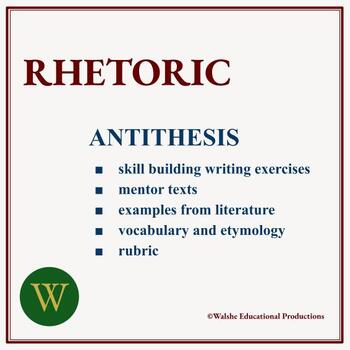
Rhetoric Lesson Twenty-six: Antithesis
Rhetoric lessons are a great way of introducing students to figures of speech and how to use them. This no-prep lesson in antithesis is the twenty-sixth in my series of thirty rhetoric lessons. Simple, easy to follow instructions and examples are included, along with practice exercises and a rubric. I use these lessons with students from grades 7 to 12. They enjoy the simple challenge of writing according to the form of each rhetorical device. Students from a variety of skill levels, including E
Subjects:
Grades:
7th - 12th, Adult Education
CCSS:
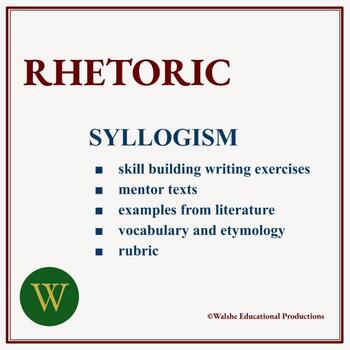
Rhetoric Lesson Twenty-one: Syllogism
Rhetoric lessons are a great way of introducing students to figures of speech and how to use them. This no-prep lesson in syllogism is the twenty-first in my series of thirty rhetoric lessons. Simple, easy to follow instructions and examples are included, along with practice exercises and a rubric. I use these lessons with students from grades 7 to 12. They enjoy the simple challenge of writing according to the form of each rhetorical device. Students from a variety of skill levels, including En
Subjects:
Grades:
7th - 12th, Adult Education
CCSS:
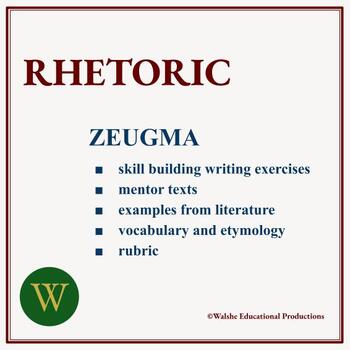
Rhetoric Lesson Twenty-seven: Zeugma
Rhetoric lessons are a great way of introducing students to figures of speech and how to use them. This no-prep lesson in antithesis is the twenty-seventh in my series of thirty rhetoric lessons. Simple, easy to follow instructions and examples are included, along with practice exercises and a rubric. I use these lessons with students from grades 7 to 12. They enjoy the simple challenge of writing according to the form of each rhetorical device. Students from a variety of skill levels, including
Subjects:
Grades:
7th - 12th, Adult Education
CCSS:
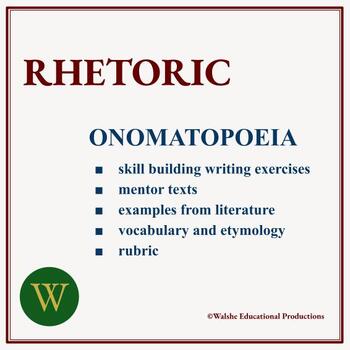
Rhetoric Lesson Twenty-four: Onomatopoeia
Rhetoric lessons are a great way of introducing students to figures of speech and how to use them. This no-prep lesson in onomatopoeia is the twenty-fourth in my series of thirty rhetoric lessons. Simple, easy to follow instructions and examples are included, along with practice exercises and a rubric. I use these lessons with students from grades 7 to 12. They enjoy the simple challenge of writing according to the form of each rhetorical device. Students from a variety of skill levels, includin
Subjects:
Grades:
7th - 12th, Adult Education
CCSS:

Rhetoric Lesson Twenty-two: Tautology
Rhetoric lessons are a great way of introducing students to figures of speech and how to use them. This no-prep lesson in tautology is the twenty-second in my series of thirty rhetoric lessons. Simple, easy to follow instructions and examples are included, along with practice exercises and a rubric. I use these lessons with students from grades 7 to 12. They enjoy the simple challenge of writing according to the form of each rhetorical device. Students from a variety of skill levels, including E
Subjects:
Grades:
7th - 12th, Adult Education
CCSS:
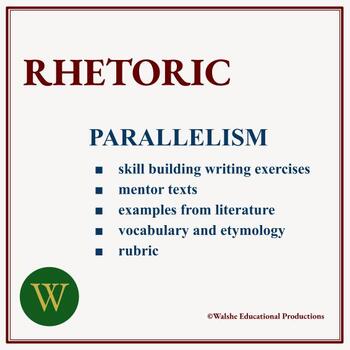
Rhetoric Lesson Twenty: Parallelism
Rhetoric lessons are a great way of introducing students to figures of speech and how to use them. This no-prep lesson in parallelism is the twentieth in my series of thirty rhetoric lessons. Simple, easy to follow instructions and examples are included, along with practice exercises and a rubric. I use these lessons with students from grades 7 to 12. They enjoy the simple challenge of writing according to the form of each rhetorical device. Students from a variety of skill levels, including Eng
Subjects:
Grades:
7th - 12th, Adult Education
CCSS:
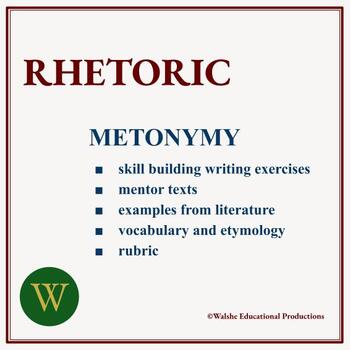
Rhetoric Lesson Thirty: Metonymy
Rhetoric lessons are a great way of introducing students to figures of speech and how to use them. This no-prep lesson in metonymy is the thirtieth in my series of thirty rhetoric lessons. Simple, easy to follow instructions and examples are included, along with practice exercises and a rubric. I use these lessons with students from grades 7 to 12. They enjoy the simple challenge of writing according to the form of each rhetorical device. Students from a variety of skill levels, including Englis
Subjects:
Grades:
7th - 12th, Adult Education
CCSS:

Rhetoric Lesson Twenty-nine: Simile
Rhetoric lessons are a great way of introducing students to figures of speech and how to use them. This no-prep lesson in simile is the twenty-ninth in my series of thirty rhetoric lessons. Simple, easy to follow instructions and examples are included, along with practice exercises and a rubric. I use these lessons with students from grades 7 to 12. They enjoy the simple challenge of writing according to the form of each rhetorical device. Students from a variety of skill levels, including Engli
Subjects:
Grades:
7th - 12th, Adult Education
CCSS:
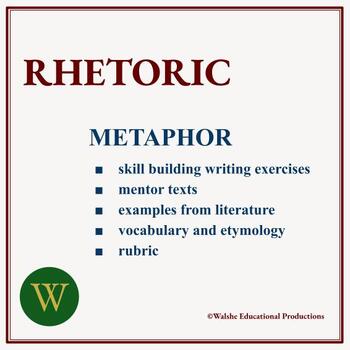
Rhetoric Lesson Twenty-eight: Metaphor
Rhetoric lessons are a great way of introducing students to figures of speech and how to use them. This no-prep lesson in metaphor is the twenty-eighth in my series of thirty rhetoric lessons. Simple, easy to follow instructions and examples are included, along with practice exercises and a rubric. I use these lessons with students from grades 7 to 12. They enjoy the simple challenge of writing according to the form of each rhetorical device. Students from a variety of skill levels, including En
Subjects:
Grades:
7th - 12th, Adult Education
CCSS:

Rhetoric Lesson Thirteen: Oxymoron
Rhetoric lessons are a great way of introducing students to figures of speech and how to use them. This no-prep lesson in oxymoron is the thirteenth in my series of thirty rhetoric lessons. Simple, easy to follow instructions and examples are included, along with practice exercises and a rubric. I use these lessons with students from grades 7 to 12. They enjoy the simple challenge of writing according to the form of each rhetorical device. Students from a variety of skill levels, including Engli
Subjects:
Grades:
7th - 12th, Adult Education
CCSS:
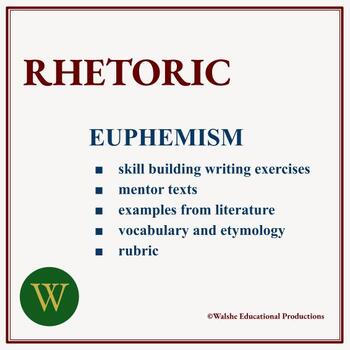
Rhetoric Lesson Twenty-three: Euphemism
Rhetoric lessons are a great way of introducing students to figures of speech and how to use them. This no-prep lesson in euphemism is the twenty-third in my series of thirty rhetoric lessons. Simple, easy to follow instructions and examples are included, along with practice exercises and a rubric. I use these lessons with students from grades 7 to 12. They enjoy the simple challenge of writing according to the form of each rhetorical device. Students from a variety of skill levels, including En
Subjects:
Grades:
7th - 12th, Adult Education
CCSS:

Rhetoric Lesson Nineteen: Consonance
Rhetoric lessons are a great way of introducing students to figures of speech and how to use them. This no-prep lesson in consonance is the nineteenth in my series of thirty rhetoric lessons. Simple, easy to follow instructions and examples are included, along with practice exercises and a rubric. I use these lessons with students from grades 7 to 12. They enjoy the simple challenge of writing according to the form of each rhetorical device. Students from a variety of skill levels, including Eng
Subjects:
Grades:
7th - 12th, Adult Education
CCSS:

Rhetoric Lesson Eighteen: Assonance
Rhetoric lessons are a great way of introducing students to figures of speech and how to use them. This no-prep lesson in assonance is the eighteenth in my series of thirty rhetoric lessons. Simple, easy to follow instructions and examples are included, along with practice exercises and a rubric. I use these lessons with students from grades 7 to 12. They enjoy the simple challenge of writing according to the form of each rhetorical device. Students from a variety of skill levels, including Engl
Subjects:
Grades:
7th - 12th, Adult Education
CCSS:

Rhetoric Lesson Sixteen: Bathos
Rhetoric lessons are a great way of introducing students to figures of speech and how to use them. This no-prep lesson in bathos is the sixteenth in my series of thirty rhetoric lessons. Simple, easy to follow instructions and examples are included, along with practice exercises and a rubric. I use these lessons with students from grades 7 to 12. They enjoy the simple challenge of writing according to the form of each rhetorical device. Students from a variety of skill levels, including English
Subjects:
Grades:
7th - 12th, Adult Education
CCSS:

Rhetoric Lesson Fifteen: Anacoluthon
Rhetoric lessons are a great way of introducing students to figures of speech and how to use them. This no-prep lesson in anacoluthon is the fifteenth in my series of thirty rhetoric lessons. Simple, easy to follow instructions and examples are included, along with practice exercises and a rubric. I use these lessons with students from grades 7 to 12. They enjoy the simple challenge of writing according to the form of each rhetorical device. Students from a variety of skill levels, including Eng
Subjects:
Grades:
7th - 12th, Adult Education
CCSS:

Rhetoric Lesson Seventeen: Litotes
Rhetoric lessons are a great way of introducing students to figures of speech and how to use them. This no-prep lesson in litotes is the seventeenth in my series of thirty rhetoric lessons. Simple, easy to follow instructions and examples are included, along with practice exercises and a rubric. I use these lessons with students from grades 7 to 12. They enjoy the simple challenge of writing according to the form of each rhetorical device. Students from a variety of skill levels, including Engli
Subjects:
Grades:
7th - 12th, Adult Education
CCSS:
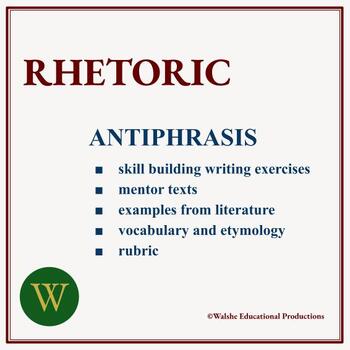
Rhetoric Lesson Fourteen: Antiphrasis
Rhetoric lessons are a great way of introducing students to figures of speech and how to use them. This no-prep lesson in antiphrasis is the fourteenth in my series of thirty rhetoric lessons. Simple, easy to follow instructions and examples are included, along with practice exercises and a rubric. I use these lessons with students from grades 7 to 12. They enjoy the simple challenge of writing according to the form of each rhetorical device. Students from a variety of skill levels, including En
Subjects:
Grades:
7th - 12th, Adult Education
CCSS:
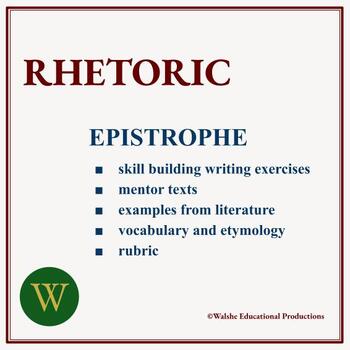
Rhetoric Lesson Two: Epistrophe
Rhetoric lessons are a great way of introducing students to figures of speech and how to use them. This no-prep lesson in epistrophe is the second in my series of thirty rhetoric lessons. Simple, easy to follow definitions and examples are included, along with practice exercises and a rubric. I use these lessons with students from grades 7 to 12. They enjoy the simple challenge of writing according to the form of each rhetorical device. Students from a variety of skill levels, including English
Subjects:
Grades:
7th - 12th, Adult Education
CCSS:
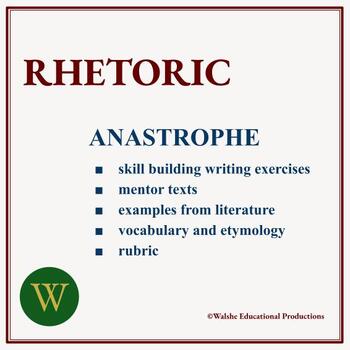
Rhetoric Lesson Twelve: Anastrophe
Rhetoric lessons are a great way of introducing students to figures of speech and how to use them. This no-prep lesson in anastrophe is the twelfth in my series of thirty rhetoric lessons. Simple, easy to follow instructions and examples are included, along with practice exercises and a rubric. I use these lessons with students from grades 7 to 12. They enjoy the simple challenge of writing according to the form of each rhetorical device. Students from a variety of skill levels, including Englis
Subjects:
Grades:
7th - 12th, Adult Education
CCSS:
Showing 1-24 of 50 results

